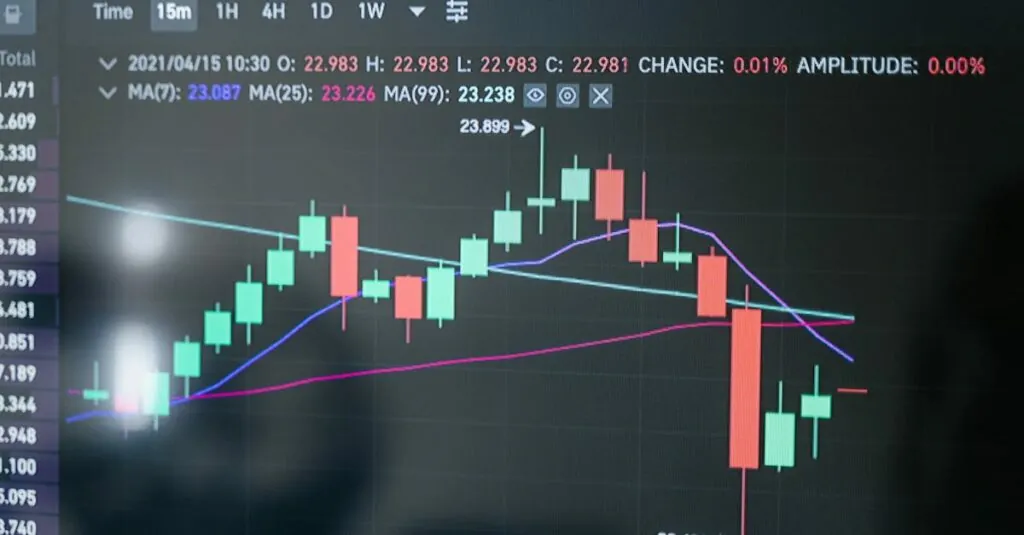Table of Contents
ToggleThe Indian stock market has always been a rollercoaster ride, but lately, it’s felt more like a bumpy ride on a rickety old bus. Investors brace themselves as they watch their portfolios tumble faster than a Bollywood star in a dramatic fall scene. One moment, it’s all smiles and profits, and the next, it’s panic mode as the market takes a nosedive.
Overview Of The Indian Stock Market Crash
The Indian stock market has encountered significant downturns, leading to increasing concerns among investors. Major indices, including the Nifty 50 and the Sensex, witnessed sharp declines, often dropping over 10% within weeks. Panic selling triggered by negative economic indicators and geopolitical tensions shocked many. This recent crash reflects growing investor anxiety, particularly as economic growth projections dim.
Investors observed volatility aligning with global market trends, where external factors played a crucial role. For instance, rising inflation rates, fluctuating currency values, and tightening monetary policies contribute to market instability. As a result, many turned to safer assets, leading to reduced trading volumes and increased selling pressure in the stock market.
Historical comparisons show that similar crashes occurred during the 2008 financial crisis and the early days of the COVID-19 pandemic. Each event sparked a wave of panic, prompting investors to reassess their strategies. Many experienced losses, leading to questions about long-term market resilience. Understanding patterns in past crashes can aid in mitigating future risks.
Experts stress the importance of maintaining a diversified portfolio during such tumultuous times. Defensive stocks, including utilities and consumer staples, often weather downturns better than cyclical sectors. Investors who’ve maintained flexibility in their investment strategies generally manage shocks more effectively. Amidst the unpredictability, staying informed and cautious remains crucial for navigating these challenging market conditions.
Causes Of The Crash
Multiple factors contribute to the Indian stock market crash. Economic influences and political dynamics play significant roles in market fluctuations.
Economic Factors
High inflation rates negatively impact consumer spending. Rising costs for essentials, such as food and energy, reduce disposable income. Weak economic indicators, like declining GDP growth, signal potential recession. Investors react by selling off shares, fearing reduced corporate earnings. Currency volatility also erodes investor confidence, as fluctuations in the rupee can affect trade and foreign investment. Additionally, central banks tightening monetary policy to combat inflation can lead to increased borrowing costs. These collective economic pressures create an environment ripe for market downturns.
Political Factors
Uncertainty in government policies introduces volatility. Regulatory changes can affect key sectors, leading to investor apprehension. Geopolitical tensions also create fear among market participants, driving them to liquidate positions. Recent events, including changes in tax structures or trade agreements, exacerbate anxiety. Local political instability may further undermine investor trust, prompting a flight to safer assets. As events unfold, markets respond swiftly, and this reaction often leads to sharp declines in major indices. Overall, political factors continually influence investor sentiment and market stability.
Impact On Investors
Market volatility significantly affects both retail and institutional investors in the Indian stock market. Sudden downturns force investors to quickly adapt strategies.
Retail Investors
Retail investors face heightened anxiety during market crashes. Many individuals, lacking extensive market knowledge, panic sell as their portfolios decline. Since emotions drive decisions, this often leads to losses. Short-term strategies may become ineffective in a bearish market. Keeping a diversified portfolio eases risks and can cushion against sudden losses. Access to technology has empowered retail investors to stay updated on trends. Tools and resources help them react promptly to shifts in the market.
Institutional Investors
Institutional investors respond differently to market volatility. These organizations usually employ research-driven strategies in managing large portfolios. They often adjust asset allocations to minimize losses during downturns. Many institutional investors focus on long-term performance rather than short-term fluctuations. Despite the crash, some identify opportunities to invest in undervalued assets. Their ability to absorb financial shocks often shields them from severe impacts. Stable cash reserves allow them to capitalize on market corrections effectively.
Historical Context
The Indian stock market has a complex history marked by significant downturns. Understanding past market crashes provides insight into current volatility.
Previous Market Crashes
The 2008 financial crisis profoundly affected India’s stock market, leading to a decline of approximately 60% in major indices. This sharp drop prompted widespread panic among investors. Similarly, the COVID-19 pandemic in early 2020 resulted in declines exceeding 30% within weeks. Each of these events highlighted how global economic factors can trigger local market reactions. Historical data indicates the Nifty 50 and Sensex often respond strongly to global shifts, demonstrating the interconnectedness of markets. Market participants experienced similar emotional responses during these crashes, with many panicking amidst uncertainty and selling off shares aggressively.
Lessons Learned
The volatility during previous crashes emphasizes the need for strategic investment practices. Investors gained valuable insights into the importance of diversification as a risk mitigation strategy. Maintaining a balanced portfolio helps shield against significant losses in downturns. Research-driven investment approaches became essential for institutional investors. Flexibility in adjusting asset allocations allowed them to optimize returns, even during turbulent times. Additionally, emotional resilience plays a critical role for retail investors. Increasing market knowledge and understanding long-term trends can empower individuals to navigate market fluctuations more effectively. Overall, recognizing the patterns and impacts of past crashes promotes better preparedness for future volatility.
Recovery And Future Outlook
Recovery in the Indian stock market hinges on several factors, including economic indicators and investor sentiment. Economic growth projections indicate potential stabilization as inflation pressures ease. Analysts monitor GDP growth and employment data closely, expecting gradual improvement.
Investor confidence plays a vital role as well. As the market begins to show signs of recovery, retail and institutional investors alike reassess their strategies. Retail investors must focus on education and emotional resilience to navigate future volatility effectively. Institutional investors can leverage research-driven insights to identify undervalued assets.
The stock market can expect fluctuations influenced by geopolitical developments and domestic policy changes. Analysts suggest the importance of proactive asset allocation during uncertain times. Diversification remains critical for risk management, allowing investors to spread exposure across various sectors.
Historical context provides insight into potential recovery patterns. The impact of past downturns like the 2008 financial crisis and the COVID-19 pandemic illustrates that markets often rebound over time. Economic reforms and policy adjustments can facilitate recovery, rebuilding investor confidence.
Experts highlight defensive stocks and sectors positioned for growth. Sectors such as technology and consumer goods may offer resilience. Renewed focus on sustainability and innovation could drive new investment opportunities.
While recovery appears possible, it will depend on numerous factors, including economic stability and investor behavior. Close attention to market movements and strategic planning are essential for navigating future challenges effectively.
The current state of the Indian stock market reflects a complex interplay of economic and political factors that continue to shape investor sentiment. As volatility persists it’s essential for both retail and institutional investors to adapt their strategies accordingly. Emphasizing diversification and maintaining a long-term perspective can help mitigate risks during uncertain times.
Investors should remain vigilant and informed about market trends while considering opportunities in defensive sectors. The lessons learned from past downturns highlight the importance of emotional resilience and strategic planning. As the market navigates these challenges recovery is possible with the right approach and a focus on informed decision-making.




